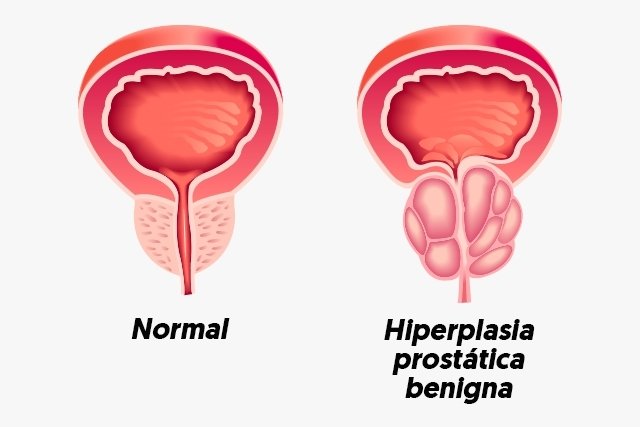Benign prostatic hyperplasia (BPH) is the enlargement of the prostate causing urinary symptoms such as frequent urge to urinate, difficulty completely emptying the bladder or the presence of a weak stream of urine, for example.
Prostate hyperplasia, also known as benign prostatic hyperplasia, can appear naturally with age in most men, being a very common male problem after the age of 50.
Depending on the degree of prostate change and symptoms, treatment may involve just the use of medication or may require surgery, and to select the best option it is important to speak to your doctor.

Symptoms of benign prostatic hyperplasia
The main symptoms of benign prostatic hyperplasia symptoms are:
- Frequent and urgent urge to urinate;
- Difficulty starting to urinate;
- Waking up frequently during the night to urinate;
- Fraco or choppy urine flow;
- Feeling of the bladder still full after urinating.
These symptoms generally appear after the age of 50 and can worsen over time, as the prostate increases in size, which ends up squeezing the urethra and affecting the urinary system.
However, it is also possible that the severity of symptoms is not directly related to the size of the prostate, as there are several patients who experience symptoms even with a slight enlargement of the prostate. See what other problems can cause similar symptoms.
Don’t ignore your symptoms!
Since there are several urinary problems that can cause symptoms similar to those of prostatic hyperplasia, such as urinary tract infection, prostate inflammation, kidney stones or even prostate cancer, it is very important to consult a urologist.
The doctor, after evaluating the man’s symptoms and history, may generally order several tests such as prostate ultrasound, urinalysis, PSA test, MRI or even prostate biopsy, for example, to confirm the diagnosis and rule out other conditions. with similar symptoms, such as prostate infection or even cancer. See the main signs of prostate cancer.
What causes prostatic hyperplasia
There is still no specific cause to justify the increase in the size of the prostate, however, it is possible that benign prostate hyperplasia is caused by a gradual growth of the gland that occurs due to the hormonal changes that men experience with natural aging.
However, some factors are known that appear to increase the risk of developing benign prostatic hyperplasia:
- Be over 50 years old;
- Have a family history of prostate problems;
- Have heart disease or diabetes;
- Sedentary lifestyle;
- High-fat diet.
Furthermore, physical exercise appears to be a protective factor for prostate hyperplasia. Thus, obese or overweight men are at greater risk of developing BPH.
How the treatment is carried out
Treatment for benign prostatic hyperplasia varies depending on the size of the prostate, the man’s age and the type of symptoms. Therefore, the best form of treatment should always be discussed with the urologist. Some of the most used forms are:
1. Remedies for benign prostatic hyperplasia
This type of treatment is generally used in men with mild to moderate symptoms and may include the use of different medications, such as:
- Alpha blockerssuch as Tamsulosin or Doxazosin: relax the bladder neck muscles and prostate fibers, facilitating urination;
- 5-alpha-reductase inhibitorssuch as Finasteride or Dutasteride: reduce the size of the prostate by inhibiting some hormonal processes;
- Tadalafil: It is a medicine widely used for erectile dysfunction, but it can also reduce the symptoms of prostatic hyperplasia.
These medications can be used separately or in combination, depending on the type of symptoms.
2. Minimally invasive therapies
Minimally invasive therapies are used especially in cases of men with moderate or severe symptoms, who have not improved with the medications prescribed by their doctor or if they have any signs of complication due to prostate growth, such as bladder stones, recurrent urinary tract infections. , worsening kidney function, among others.
There are several techniques, most of which can cause some side effects, such as retrograde ejaculation, slight bleeding in the urine in the immediate post-operative period, and slight temporary burning. Therefore, all options should be discussed carefully with the urologist.
Some of the most used techniques are transurethral resection of the prostate (TURP), electrovaporization of the prostate (greenlight), prostate enucleation (BipoLep, GreenLep, HolLEp) and adenomectomy, which can be open, laparoscopic or robotic.
3. Surgery
Surgery is normally performed to remove the “core” of the prostate and definitively resolve all symptoms, and is recommended when none of the other forms of treatment have shown results. This surgery can be performed laparoscopically or classically, through a cut in the belly.
See how this surgery is performed and what the recovery is like.
Bibliography
- LANGAN, R. C. Benign Prostatic Hyperplasia. First Care. 46. 2; 223-232, 2019
- MIERNIK, A.; GRATZKE, C. Current Treatment for Benign Prostatic Hyperplasia. Dtsch Ärztebl Int. 117. 49; 843-854, 2020
- RASTRELLI, G.; et al. Testosterone and Benign Prostatic Hyperplasia. Sex With Rev. 7. 2; 259-271, 2019
- MADERSBACHER, S.; et al. Pathophysiology of Benign Prostatic Hyperplasia and Benign Prostatic Enlargement: A Mini-Review. Gerontology. 65. 5; 458-464, 2019

Sign up for our newsletter and stay up to date with exclusive news
that can transform your routine!
Warning: Undefined array key "title" in /home/storelat/public_html/wp-content/plugins/link-whisper-premium/templates/frontend/related-posts.php on line 12
Warning: Undefined array key "title_tag" in /home/storelat/public_html/wp-content/plugins/link-whisper-premium/templates/frontend/related-posts.php on line 13



